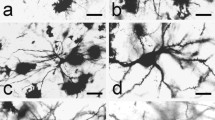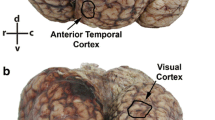Abstract
The superior cervical ganglion (SCG) in mammals varies in structure according to developmental age, body size, gender, lateral asymmetry, the size and nuclear content of neurons and the complexity and synaptic coverage of their dendritic trees. In small and medium-sized mammals, neuron number and size increase from birth to adulthood and, in phylogenetic studies, vary with body size. However, recent studies on larger animals suggest that body weight does not, in general, accurately predict neuron number. We have applied design-based stereological tools at the light-microscopic level to assess the volumetric composition of ganglia and to estimate the numbers and sizes of neurons in SCGs from rats, capybaras and horses. Using transmission electron microscopy, we have obtained design-based estimates of the surface coverage of dendrites by postsynaptic apposition zones and model-based estimates of the numbers and sizes of synaptophysin-labelled axo-dendritic synaptic disks. Linear regression analysis of log-transformed data has been undertaken in order to establish the nature of the relationships between numbers and SCG volume (Vscg). For SCGs (five per species), the allometric relationship for neuron number (N) is N=35,067×V 0.781scg and that for synapses is N=20,095,000×V 1.328scg , the former being a good predictor and the latter a poor predictor of synapse number. Our findings thus reveal the nature of SCG growth in terms of its main ingredients (neurons, neuropil, blood vessels) and show that larger mammals have SCG neurons exhibiting more complex arborizations and greater numbers of axo-dendritic synapses.






Similar content being viewed by others
References
Abrahão LM, Nyengaard JR, Sasahara TH, Gomes SP, Oliveira FR, Ladd FV, Ladd AA, Melo MP, Machado MR, Melo SR, Ribeiro AA (2009) Asymmetric post-natal development of the superior cervical ganglion of pacas (Agouti paca). Int J Dev Neurosci 27:37–45
Andrews TJ (1996) Autonomic nervous system as a model of neuronal aging: the role of target tissues and neurotrophic factors. Microsc Res Tech 35:2–19
Baddeley AJ, Gundersen HJG, Cruz-Orive LM (1986) Estimation of surface area from vertical sections. J Microsc 142:259–276
Boyd HD, McLachlan EM, Keast JR, Inokuchi H (1996) Three electrophysiological classes of guinea pig sympathetic postganglionic neurone have distinct morphologies. J Comp Neurol 369:372–387
Calhoun ME, Jucker M, Martin LJ, Thinakaran G, Price DL, Mouton PR (1996) Comparative evaluation of synaptophysin-based methods for quantification of synapses. J Neurocytol 25:821–828
Field PM, Raisman G (1985) The density of reinnervation of adult rat superior cervical sympathetic ganglionic neurons is limited by the number of available postsynaptic sites. Brain Res 360:398–402
Fioretto ET, Abreu RN, Castro MF, Guidi WL, Ribeiro AA (2007) Macro- and microstructure of the superior cervical ganglion in dogs, cats and horses during maturation. Cells Tissues Organs 186:129–140
Forehand CJ (1985) Density of somatic innervation on mammalian autonomic ganglion cells is inversely related to dendritic complexity and preganglionic convergence. J Neurosci 5:3403–3408
Gabella G, Trigg P, Mcphail H (1988) Quantitative cytology of ganglion neurons and satellite glial cells in the superior cervical ganglion of the sheep. Relationship with ganglion neuron size. J Neurocytol 17:753–769
Gagliardo KM, Guidi WL, Da Silva RA, Ribeiro AA (2003) Macro and microstructural organization of the dog’s caudal mesenteric ganglion complex (Canis familiaris). Anat Histol Embryol 32:236–243
Gagliardo KM, Carvalho BJC, Souza RR, Ribeiro AA (2005) Postnatal-related changes in the size and total number of neurons in the caudal mesenteric ganglion of dogs: total number of neurons can be predicted from body weight and ganglion volume. Anat Rec 286:917–929
Gibbins IL, Matthew SE (1996) Dendritic morphology of presumptive vasoconstrictor and pilomotor neurons and their relations with neuropeptide-containing preganglionic fibres in lumbar sympathetic ganglia of guinea-pigs. Neuroscience 70:999–1012
Gibbins IL, Morris JL (2006) Structure of peripheral synapses: autonomic ganglia. Cell Tissue Res 326:205–220
Gibbins IL, Rodgers HF, Matthew SE, Murphy SM (1998) Synaptic organisation of lumbar sympathetic ganglia of guinea pigs: serial section ultrastructural analysis of dye-filled sympathetic final motor neurons. J Comp Neurol 402:285–302
Gibbins IL, Teo EEH, Jobling P, Morris JL (2003) Synaptic density, convergence, and dendritic complexity of prevertebral sympathetic neurons. J Comp Neurol 455:285–298
Gundersen HJG (1977) Notes of the estimation of the numerical density of arbitrary profiles: the edge effect. J Microsc 111:219–223
Gundersen HJG (1986) Stereology of arbitrary particles. A review of unbiased number and size estimators and presentation of some new ones, in memory of William R. Thompson. J Microsc 143:3–45
Gundersen HJG (1988) The nucleator. J Microsc 151:3–21
Gundersen HJG, Jensen EB (1987) The efficiency of systematic sampling in stereology and its prediction. J Microsc 147:229–263
Gundersen HJG, Jensen EB, Kiêu K, Nielsen J (1999) The efficiency of systematic sampling in stereology: reconsidered. J Microsc 193:199–211
Hedger JH, Webber RH (1976) Anatomical study of the cervical sympathetic trunk and ganglia in the albino rat (Mus norvegicus albinus). Acta Anat (Basel) 96:206–217
Hilbe M, Guscetti F, Wunderlin S, Ehrensperger F (2005) Synaptophysin: an immunohistochemical marker for animal dysautonomias. J Comp Pathol 132:223–227
Howard CV, Reed MG (2005) Unbiased stereology. Three-dimensional measurement in microscopy. Bios Scientific, Liverpool, Oxford
Hui E, Bai J, Chapman ER (2006) Ca2+-triggered simultaneous membrane penetration of the tandem C2-domains of synaptotagmin I. J Biophys 91:1767–1777
Janz R, Südhof TC, Hammer RE, Unni V, Siegelbaum SA, Bolshakov VY (1999) Essential roles in synaptic plasticity for synaptogyrin I and synaptophysin I. Neuron 24:687–700
Leube RE (1994) Expression of the synaptophysin gene family is not restricted to neuronal and neuroendocrine differentiation in rat and human. Differentiation 56:163–71
Lima AR, Nyengaard JR, Jorge AA, Balieiro JC, Peixoto C, Fioretto ET, Ambrósio CE, Miglino MA, Zatz M, Ribeiro AA (2007) Muscular dystrophy-related quantitative and chemical changes in adenohypophysis GH-cells in golden retrievers. Growth Horm IGF Res 17:480–491
Matthews MR (1983) The ultrastructure of junctions in sympathetic ganglia of mammals. In: Elvin LG (ed) Autonomic ganglia. Wiley Chichester, New York, pp 27–66
Mayhew TM (1979) Stereological approach to the study of synapse morphometry with particular regard to estimating number in a volume and on a surface. J Neurocytol 8:121–138
Mayhew TM (1991) The accurate prediction of Purkinje cell number from cerebellar weight can be achieved with the fractionator. J Comp Neurol 308:162–168
Mayhew TM (1996) How to count synapses unbiasedly and efficiently at the ultrastructural level: proposal for a standard sampling and counting protocol. J Neurocytol 25:793–804
McLachlan EM (1995) Autonomic ganglia. Harwood, Luxembourg
McLachlan EM, Meckler R (1989) Characteristics of synaptic input to three classes of sympathetic neurone in the coeliac ganglion of the guinea-pig. J Physiol (Lond) 415:109–129
Melo SR, Nyengaard JR, Roza OF, Ladd FV, Abrahão LM, Machado MR, Sasahara TH, Melo MP, Ribeiro AA (2009) The developing left superior cervical ganglion of pacas (Agouti paca). Anat Rec 292:966–975
Miolan J, Niel J (1996) The mammalian sympathetic prevertebral ganglia: integrative properties and role in the nervous control of digestive tract motility. J Auton Nerv Syst 58:125–38
Mochida S, Nonomura Y, Kobayashi H (1994) Analysis of the mechanism for acetylcholine release at the synapse formed between rat sympathetic neurons in culture. Microsc Res Tech 29:94–102
Navone F, Jahn R, Di Gioia G, Stukenbrok H, Greengard P, De Camilli P (1986) Protein p38: an integral membrane protein specific for small vesicles of neurons and neuroendocrine cells. J Cell Biol 103:2511–2527
Nyengaard JR, Gundersen HJG (1992) The isector: a simple and direct method for generating isotropic, uniform random sections from small specimens. J Microsc 165:427–431
Östberg AJC, Raisman G, Field PM, Iversen LL, Zigmond RE (1976) A quantitative comparison of the formation of synapses in the rat superior cervical ganglion by its own and by foreign nerve fibres. Brain Res 107:445–470
Purves D, Lichtman JW (1985) Geometrical differences among homologous neurons in mammals. Science 228:298–302
Purves D, Rubin E, Snider WD, Lichtman J (1986) Relation of animal size to convergence, divergence and neuronal number in peripheral sympathetic pathways. J Neurosci 6:158–163
Rao H, Pio J, Kessler JP (1999) Postnatal development of synaptophysin immunoreactivity in the rat nucleus tractus solitarii and caudal ventrolateral medulla. Brain Res Dev Brain 112:281–285
Ribeiro AA (2006) Size and number of binucleate and mononucleate superior cervical ganglion neurons in young capybaras. Anat Embryol 211:607–617
Ribeiro AA, Elias CF, Liberti EA, Guidi WL, De Souza RR (2002) Structure and ultrastructure of the celiac mesenteric ganglion complex in the domestic dog (Canis familiaris). Anat Histol Embryol 31:344–349
Ribeiro AA, Davis C, Gabella G (2004) Estimate of size and total number of neurons in superior cervical ganglion of rat, capybara and horse. Anat Embryol 208:367–380
Sasahara TH, De Souza RR, Machado MR, Da Silva RA, Guidi WL, Ribeiro AA (2003) Macro- and microstructural organization of the rabbit's celiac-mesenteric ganglion complex (Oryctolagus cuniculus). Ann Anat 185:441–448
Scherle W (1970) A simple method for volumetry of organs in quantitative stereology. Mikroskopie 26:57–60
Siklós L, Párducz A, Halász N, Rickmann M, Joó F, Wolff JR (1990) An unbiased estimation of the total number of synapses in the superior cervical ganglion of adult rats established by the dissector method. Lack of change after long-lasting sodium bromide administration. J Neurocytol 19:443–454
Smolen AJ, Beaston-Wimmer P (1986) Dendritic development in the rat superior cervical ganglion. Brain Res 394:245–252
Smolen AJ, Raisman G (1980) Synapse formation in the rat superior cervical ganglion during normal development and after neonatal deafferentation. Brain Res 181:315–323
Sokal RR, Rohlf FJ (1981) Biometry. The principles and practice of statistics in biological research. Freeman, San Francisco
Steele C, Fioretto ET, Sasahara TH, Guidi WL, Lima AR de, Ribeiro AA, Loesch A (2006) On the atrophy of the internal carotid artery in capybara. Cell Tissue Res 326:737–748
Stone KC, Mercer RR, Gehr P, Stockstill B, Crapo JD (1992) Allometric relationships of cell numbers and sizes in the mammalian lung. Am J Resp Cell Mol Biol 6:235–243
Szabat E, Vanhatalo S, Soinila S (1998) The ontogenic appearance of tyrosine hydroxylase-, serotonin-, gamma-aminobutyric acid-, calcitonin gene-related peptide-, substance P-, and synaptophysin-immunoreactivity in rat pituitary gland. Int J Dev Neurosci 16:449–60
Tandrup T (1993) A method for unbiased and efficient estimation of number and mean volume of specified neuron subtypes in rat dorsal root ganglion. J Comp Neurol 329:269–276
Tandrup T, Braendgaard H (1994) Number and volume of rat dorsal root ganglion cells in acrylamide intoxication. J Neurocytol 23:242–248
Tang J, Maximov A, Shin OH, Dai H, Rizo J, Sudhof TC (2006) A complexin/synaptotagmin 1 switch controls fast synaptic vesicle exocytosis. Cell 126:1175–1187
Tarsa L, Goda Y (2002) Synaptophysin regulates activity-dependent synapse formation in cultured hippocampal neurons. Proc Natl Acad Sci USA 99:1012–1016
Toscano CP, Melo MP, Matera JM, Loeschm A, Ribeiro AA (2009) The developing and restructuring superior cervical ganglion of guinea pigs (Cavia porcellus var. albinus). Int J Dev Neurosci 27:329–336
Weidenmann B, Frank WW (1985) Identification and localization of synaptophysin, an integral membrane glycoprotein of M 38,000 characteristic of presynaptic vesicles. Cell 41:1017–1028
Wright LL, Smolen AJ (1983) Neonatal testosterone treatment increases neuron and synapse numbers in male rat superior cervical ganglion. Brain Res 8:145–153
Author information
Authors and Affiliations
Corresponding author
Additional information
The Laboratory of Stochastic Stereology and Chemical Anatomy (LSSCA) is supported by São Paulo Research Foundation (FAPESP; application number: 2005/53835-6), CNPQ (470913/2006-1) and CAPES.
Rights and permissions
About this article
Cite this article
Loesch, A., Mayhew, T.M., Tang, H. et al. Stereological and allometric studies on neurons and axo-dendritic synapses in the superior cervical ganglia of rats, capybaras and horses. Cell Tissue Res 341, 223–237 (2010). https://doi.org/10.1007/s00441-010-1002-8
Received:
Accepted:
Published:
Issue Date:
DOI: https://doi.org/10.1007/s00441-010-1002-8




